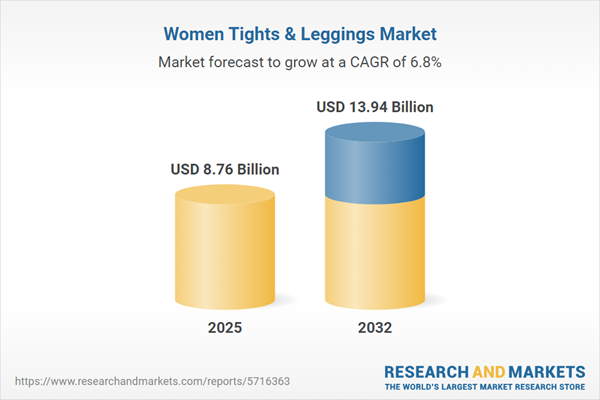Speak directly to the analyst to clarify any post sales queries you may have.
The women’s tights and leggings market is characterized by rapid shifts in consumer preference, ongoing innovations in materials, and changing distribution strategies. Senior decision-makers must maintain a comprehensive perspective to capture growth opportunities and proactively align with market trends.
Market Snapshot: Women’s Tights and Leggings Market
The global women’s tights and leggings market is on an upward path, with revenue projected to increase from USD 8.21 billion in 2024 to USD 8.76 billion in 2025, reflecting a compound annual growth rate of 6.84%. By 2032, market size is forecasted to reach USD 13.94 billion. This expansion is fostered by the mainstreaming of athleisure, digital-first retail habits, and growing attention to product longevity. Brands—both established leaders and emerging entrants—are investing in innovative textile technologies and robust omnichannel frameworks. These priorities respond to evolving consumer demands, strengthen customer engagement, and support resilient business operations in a competitive landscape.
Scope & Segmentation
This report delivers focused analysis and actionable segmentation, giving senior executives the intelligence necessary for effective decision-making. Key segments include:
- Product Types: Complete coverage of fishnet styles, jeggings in denim and faux leather, ankle-length, capri, high-waist leggings, and multiple tights options including opaque and sheer, enabling robust assortment planning.
- Distribution Channels: Examination of online retail (brand-owned and third-party platforms), specialty stores, supermarkets, hypermarkets, and discount outlets to map ideal market access pathways.
- Fabric Composition: Assessment of cotton blends (including organic), multiple nylon deniers, standard and microfiber polyester, and spandex for greater insight into durability expectations and comfort preferences.
- Price Range: Analysis spans economy (below $20), mid-range ($20–$50), and premium ($50–$100) categories, supporting strategic product positioning and precise targeting.
- Demographics: Targeted analysis of adults (25–45, 45–60), seniors (above 60), and teens (18 and under), guiding nuanced campaign development and product differentiation.
- Regional Markets: Detailed coverage of the Americas, Europe, Middle East & Africa, and Asia-Pacific to inform strategic resource allocation and region-specific adaptations.
- Leading Brands: Benchmarking Lululemon Athletica, Nike, adidas, Under Armour, Puma, Hanesbrands, Calzedonia, Wolford, Falke, and Industria de Diseño Textil allows assessment of portfolio strategies and competitive positioning.
Key Takeaways for Senior Decision-Makers
- Functional products with carefully considered aesthetics are distinguishing portfolios, benefiting from advances in flexible, comfortable materials ideally suited for today’s consumers.
- B2B buyers increasingly value suppliers that champion sustainable, high-performance fabrics, broadening reach among athletic and style-oriented segments.
- Sourcing cycles that prioritize organic and recycled input materials not only align with rising transparency standards, they enhance the responsible brand narrative now valued in procurement decisions.
- As retail channels diversify, organizations investing in adaptable procurement and distribution strategies are better positioned to manage supply challenges and anticipate regulatory complexities.
- Segment-focused innovation—adapting fabric composition, design, and sizing to key age and price brackets—improves marketing efficiency and product relevancy in competitive categories.
- Regional customization based on local trend maturity and unique consumer dynamics is increasingly required for effective market penetration and sustainable growth.
Tariff Impact on the Supply Chain
The United States’ updated 2025 tariff policy is compelling market players to re-evaluate global sourcing and distribution structures. Leading brands are renegotiating contracts, shifting production towards Central America and South Asia, and ramping up direct-to-consumer offerings to support business continuity. Tiered pricing frameworks are emerging as a core strategy to maintain supply flexibility and cushion costs. Landed cost analysis has become an essential function in procurement operations, supporting thorough contingency planning and reliable supply, particularly for digitally driven models. Some large organizations are progressing with vertical integration to achieve clearer cost controls and improved chain oversight.
Methodology & Data Sources
This assessment is built on qualitative insights from executive interviews, direct manufacturer and supply chain feedback, and extensive quantitative consumer studies. Rigorous secondary research, customs record review, and advanced modeling techniques triangulate all forecasts for maximum reliability.
Why This Report Matters
- Informs data-driven decision-making for product development, supply optimization, and omnichannel strategy grounded in actionable analytics.
- Enables precise benchmarking to help organizations navigate evolving regulatory frameworks and distribution models.
- Supports targeted resource planning and market segmentation across all key consumer demographics and regions.
Conclusion
Senior executives receive timely, actionable insights to support adaptation, sustainability objectives, and effective strategy in the dynamic women’s tights and leggings market.
Additional Product Information:
- Purchase of this report includes 1 year online access with quarterly updates.
- This report can be updated on request. Please contact our Customer Experience team using the Ask a Question widget on our website.
Table of Contents
3. Executive Summary
4. Market Overview
7. Cumulative Impact of Artificial Intelligence 2025
List of Figures
Samples

LOADING...
Companies Mentioned
The key companies profiled in this Women's Tights & Leggings market report include:- Lululemon Athletica Inc.
- Nike, Inc.
- adidas AG
- Under Armour, Inc.
- Puma SE
- Hanesbrands Inc.
- Calzedonia S.p.A.
- Wolford AG
- Falke KGaA
- Industria de Diseño Textil, S.A.
Table Information
| Report Attribute | Details |
|---|---|
| No. of Pages | 198 |
| Published | October 2025 |
| Forecast Period | 2025 - 2032 |
| Estimated Market Value ( USD | $ 8.76 Billion |
| Forecasted Market Value ( USD | $ 13.94 Billion |
| Compound Annual Growth Rate | 6.8% |
| Regions Covered | Global |
| No. of Companies Mentioned | 11 |









